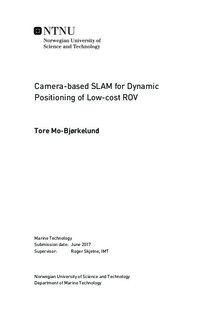Camera-based SLAM for Dynamic Positioning of Low-cost ROV
Master thesis
Permanent lenke
http://hdl.handle.net/11250/2615040Utgivelsesdato
2017Metadata
Vis full innførselSamlinger
- Institutt for marin teknikk [3472]
Sammendrag
A range of low-cost Remotely Operated Vehicles(ROVs) are currently emerging in the consumer market. In this thesis we are exploring the possibilities of using monocular camera-based Simultaneous Localization And Mapping(SLAM) on a low cost ROV for real-time position feedback, stationkeeping and dynamic positioning. Monocular SLAMhasaninherentweakness,stemmingfromthatanormalcameraisabearing-only sensor, this means that the scale of the map and the camera position within the map is unknown. We present two methods for estimating the relation between SLAM and real world scales, one based on laser range measurements using computer vision and the other based on comparing offsets in the vertical direction. We present the low-cost ROV used in this thesis, the uDrone, and the Marine Cybernetics Laboratory(MCLab). ORB-SLAM (Mur-Artal et al., 2015) is chosen as the SLAM-algorithm for the thesis. ORB-SLAM is a graph-based SLAM-algorithm based on the ORB feature descriptor (Rublee et al., 2011) and Bundle Adjustment(BA) optimization. We then present the pinhole camera model, and the distortions made of the lens shape, camera imperfections and refraction. ORB-SLAM only outputs the pose of the camera, thus, we need to estimate velocity, this is done by first presenting the system model from (Sandøy, 2016), then developing two Extended Kalman Filters)(EKFs). The first solely based on the model and inputs from the scaled ORB-SLAM pose, the second we exchange the kinematic model by Inertial Measurement Unit(IMU)-measurements in all translatory degrees of freedoms. To achieve dynamic positioning, we implement Proportional Integral Derivative(PID) control laws in sway, heave and yaw degrees of freedom, and a Pseudo Derivative Feedback(PDF) (Phelan, 1971) based control law inspired by (Kjerstadetal.,2017)insurge. ORB-SLAM,thescaleestimators, EKFsandcontrollawsare implemented in the Robot Operating System on uDrone and tested in the MCLab basin. We present the results of the experiments and comment on their performance. Both the EKFs and the scaling factor estimates showed somewhat unsatisfactory results, while the laser range measurements, controllers and ORB-SLAM showed satisfactory performance. Weconcludebyarguingthattheworkdoneinthisthesisisasuccessfulproofof concept and that if implemented on a commercial product, it needs more robustness and refinement.
